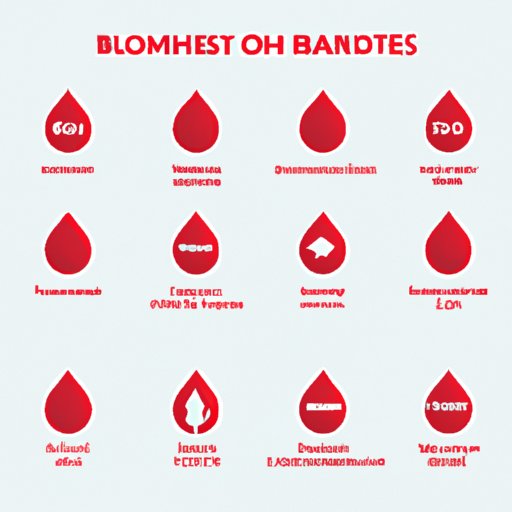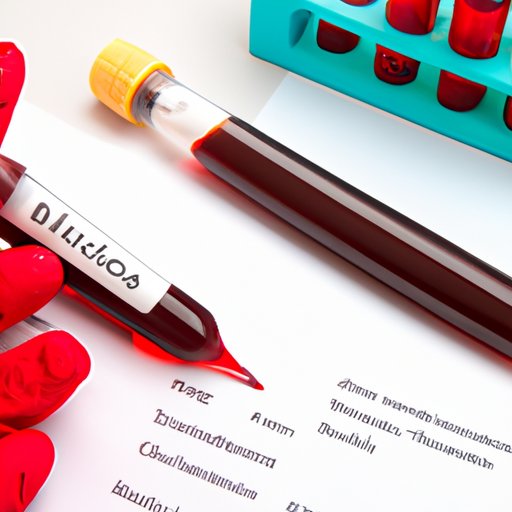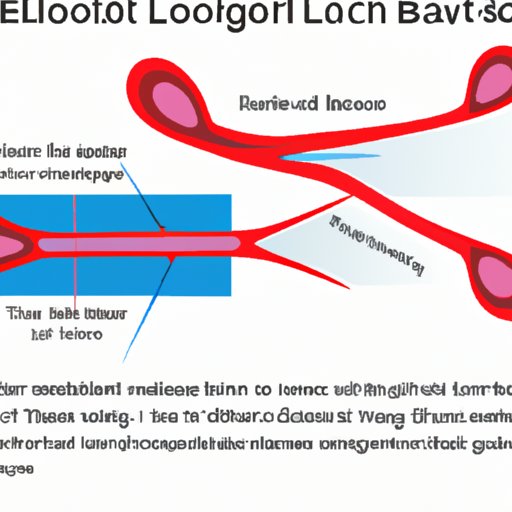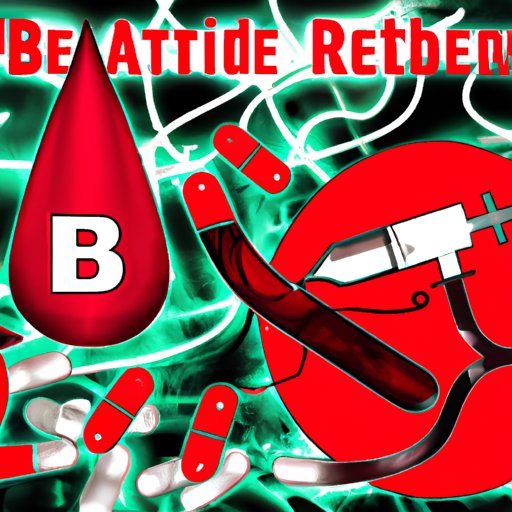Introduction
Blood clots are a normal part of the human body’s natural healing process. They form when platelets, small cells that help stop bleeding, stick together and form a plug or patch over an injured area. This helps prevent further bleeding and protects the body from infection. However, when a clot forms in an artery or vein, it can cause serious complications and even be life-threatening. In this article, we’ll explore how blood clots form and move through the body, as well as the risks associated with them and how to prevent them.
Exploring How Blood Clots Move Through the Body
The human body has an intricate system of blood vessels known as the circulatory system. This network of arteries and veins carries oxygen, nutrients, and other essential substances throughout the body. When a clot forms in a blood vessel, it can block the flow of blood and cause serious health problems. The movement of clots through the body is affected by several factors, including the size and location of the clot, the force of the blood flow, and the shape of the blood vessel.
Causes of Blood Clotting
Blood clots can form for many reasons, such as injury, surgery, and certain medical conditions. Other factors that can contribute to clot formation include smoking, obesity, and a sedentary lifestyle. Some medications, such as birth control pills, can also increase the risk of clotting.

Signs and Symptoms of Blood Clotting
The signs and symptoms of blood clotting vary depending on the location of the clot. Common symptoms include swelling, pain, redness, and warmth in the affected area. In some cases, a person may experience shortness of breath, chest pain, or dizziness. If you experience any of these symptoms, seek medical attention immediately.

Diagnosing and Treating Blood Clotting Conditions
To diagnose a blood clotting condition, your doctor will likely order a variety of tests, such as an ultrasound, CT scan, or MRI. They may also order lab tests to check for signs of inflammation or clotting factors in your blood. Treatment for blood clotting disorders usually involves anticoagulant medications, such as aspirin or warfarin, to reduce the risk of further clotting.

Understanding How Blood Clots Form and Travel
When a blood vessel is injured, platelets rush to the area and start to stick together. This creates a plug or patch, which prevents further bleeding. As the clot grows, it begins to contract, helping to move it through the bloodstream. The shape of the blood vessel and the force of the blood flow also play a role in how quickly the clot moves.
Factors That Contribute to Blood Clotting
Certain factors can increase the risk of clotting, such as age, gender, genetics, and certain medical conditions. Age is a major risk factor for blood clots, as the risk of clotting increases with age. Women are also more likely to develop blood clots than men due to hormonal changes during pregnancy and menopause. Certain genetic mutations can also increase the risk of clotting, as can certain medical conditions, such as diabetes, cancer, and heart disease.
Anatomy of a Blood Clot
A blood clot is made up of several components, including red blood cells, fibrin, and platelets. Red blood cells are responsible for carrying oxygen throughout the body, while fibrin is a protein that helps hold the clot together. Platelets are the smallest type of cell in the blood, and they help to form the plug or patch that stops bleeding. Together, these components form a clot that can travel through the bloodstream.
Where Blood Clots Typically Go
Blood clots typically travel to the lungs, heart, or brain where they can cause serious complications. Clots that form in the legs are known as deep vein thrombosis (DVT) and can cause pain, swelling, and redness in the affected area. Clots that travel to the lungs are known as pulmonary embolism (PE) and can cause breathing difficulties and chest pain. Clots that travel to the heart can cause a heart attack, while clots that travel to the brain can cause a stroke.
Risk Factors for Blood Clots and How to Avoid Them
Certain factors can increase your risk of developing a blood clot, such as being overweight, having high blood pressure, or having a family history of clotting disorders. To reduce your risk, it’s important to maintain a healthy weight, exercise regularly, and eat a balanced diet. It’s also important to avoid smoking, as smoking can increase your risk of clotting.
Strategies for Reducing Risk of Blood Clots
In addition to making lifestyle changes, there are several strategies you can use to reduce your risk of developing a blood clot. These include wearing compression stockings, avoiding long periods of sitting or standing, and taking regular breaks from work or school. You should also talk to your doctor about medications that can help reduce your risk of clotting.
Lifestyle Changes to Reduce Risk of Blood Clots
Making lifestyle changes can help reduce your risk of developing a blood clot. Eating a healthy diet, exercising regularly, and managing stress can all help lower your risk. You should also avoid smoking, as smoking can increase your risk of clotting. Finally, if you have a family history of clotting disorders, you should talk to your doctor about ways to reduce your risk.
Medications That Help Prevent Blood Clots
Some medications can help reduce your risk of developing a blood clot. These medications include anticoagulants, such as warfarin and heparin, as well as antiplatelet drugs, such as aspirin. Your doctor may also prescribe a combination of medications to help reduce your risk of clotting.
Long-Term Effects of Blood Clotting
Blood clots can cause serious long-term health effects, such as stroke, heart attack, and pulmonary embolism. Clots can also lead to organ damage, loss of limb function, and even death. If you have had a blood clot, it’s important to talk to your doctor about ways to reduce your risk of developing another one.
Complications of Blood Clotting
Blood clots can cause a variety of complications, including deep vein thrombosis (DVT), pulmonary embolism (PE), stroke, and heart attack. Clots can also lead to organ damage and loss of limb function. If you have had a blood clot, it’s important to talk to your doctor about ways to reduce your risk of developing another one.

Recent Advances in Treatment for Blood Clotting Disorders
There have been several advances in the treatment of blood clotting disorders in recent years. For example, newer anticoagulants, such as apixaban and rivaroxaban, have been approved for use in the United States. Additionally, new methods for delivering these medications, such as injections or implants, have been developed. These advances have improved the safety and effectiveness of treatment for blood clotting disorders.

Potential Future Treatments for Blood Clotting Disorders
Researchers are working on developing new treatments for blood clotting disorders. Some of these treatments involve gene therapy, which uses genes to target specific areas of the body. Other potential treatments include stem cell therapy, which uses stem cells to repair damaged tissue, and nanotechnology, which uses tiny particles to deliver medications directly to the site of the clot.
Conclusion
Blood clots are a normal part of the body’s natural healing process, but they can cause serious health problems if they form in an artery or vein. In this article, we explored how blood clots form and move through the body, as well as the risks associated with them and how to prevent them. We also looked at the long-term health effects of blood clots and the potential future treatments. By understanding how blood clots form and travel, you can take steps to reduce your risk of developing a clot and its potential complications.
(Note: Is this article not meeting your expectations? Do you have knowledge or insights to share? Unlock new opportunities and expand your reach by joining our authors team. Click Registration to join us and share your expertise with our readers.)
